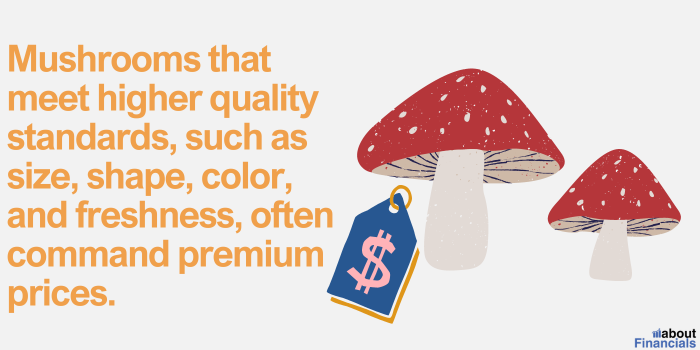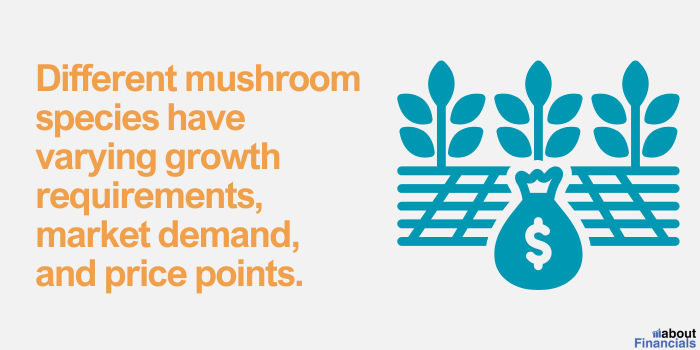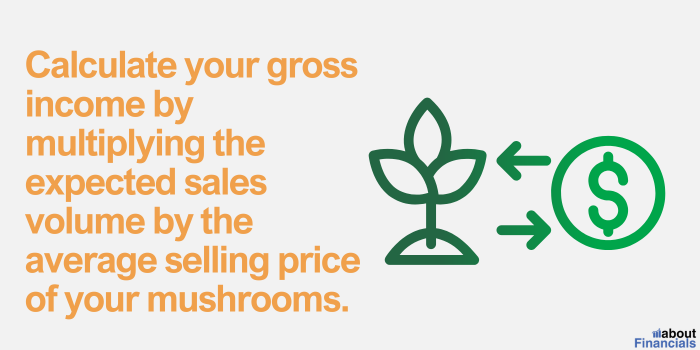Calculating the profitability of mushroom farming is crucial for any aspiring or existing mushroom farmer.
By understanding the financial aspects of your operation, you can make informed decisions, assess the feasibility of your venture, and maximize your profits. In this section, we will explore the importance of calculating mushroom profitability and discuss the key factors that influence it.
Profit calculation provides a clear picture of the financial viability of your mushroom farming business.
How much profit does a mushroom farm make?

On average, a farmer using indoor bag system can have a yield of 25 pounds mushrooms per square foot annually. According to US department of agriculture, the average price of mushroom is $1.45 pound per year. So total revenue you can expect from one square foot is around $36. It is important to mention here that the profit of a mushroom farm can vary depending on various factors such as the scale of operation, market demand, production efficiency, and cost management.
Factors influencing mushroom profitability
Several factors play a significant role in determining the profitability of your mushroom farming venture. These include:
- Market demand and pricing
The demand for mushrooms and prevailing market prices directly impact your revenue potential. Understanding market trends, consumer preferences, and pricing dynamics is essential.
- Production costs
The costs associated with mushroom farming, such as substrate materials, labor, energy, packaging, and transportation, can significantly impact profitability. Analyzing and optimizing these costs is crucial.
- Yield and production efficiency
The quantity and quality of mushrooms you can produce per unit of resources invested directly affect profitability. Maximizing yield and improving production efficiency are key considerations.
- Competition
The level of competition in the mushroom market can affect your pricing power and market share. Assessing your competitive landscape helps you position your products effectively.
- Seasonal variations
Mushroom production can be influenced by seasonal changes, affecting availability and prices. Understanding these variations helps in planning and pricing strategies.
Cost analysis
Land and infrastructure

Evaluate the cost of acquiring or leasing suitable land for mushroom cultivation. Additionally, determine the cost of essential equipment like shelving, racks, trays, misting systems, lighting, ventilation, and sterilization equipment.
Consider the expenses related to purchasing or producing substrate materials, such as compost or other organic materials.
Research the cost of acquiring high-quality mushroom spawn or mycelium from reliable suppliers.
Recurring costs
Calculate the cost of procuring substrate materials for mushroom cultivation. This can include items like straw, wood chips, sawdust, or other suitable organic materials.
Evaluate the expenses associated with labor, including wages, benefits, and training. Consider the tasks involved in mushroom cultivation, such as substrate preparation, spawning, maintenance, harvesting, and packaging.
Furthermore, estimate the costs of electricity, water, heating, and cooling required to maintain optimal growing conditions.
Lastly, it’s important to consider the expenses related to packaging materials, labeling, and transportation to distribution points or markets.
Revenue Generation
Understanding mushroom pricing
Different mushroom species may have varying market values due to factors such as demand, availability, and culinary preferences.

For instance, mushrooms that meet higher quality standards, such as size, shape, color, and freshness, often command premium prices.
Moreover, the demand for mushrooms can fluctuate throughout the year, with certain varieties being more sought after during specific seasons or events.
It’s important to analyze the pricing strategies of other mushroom farmers in your region to ensure your prices remain competitive while considering your cost structure.
Market demand and potential sales volume
Conduct market research to identify the target audience, their preferences, and the potential market size for mushrooms in your area.
Consider factors such as consumer trends, local culinary culture, dietary preferences, and the presence of competing suppliers.
Identifying target markets
Evaluate the demand from individuals, households, restaurants, farmers markets, and community-supported agriculture (CSA) programs in your area.
Additionally, explore potential partnerships with grocery stores, supermarkets, specialty food stores, caterers, and foodservice companies.
Consider supplying mushroom spawn or mycelium to hobbyists, home growers, and other mushroom farmers.
Sales channels
Selling directly to consumers through farm stands, farmers markets, online platforms, or a farm store.
You need to establishing relationships with wholesalers or distributors who can purchase mushrooms in bulk.
Moreover, you can also consider approaching local grocery stores, specialty shops, or restaurants to stock and sell your mushrooms.
To get maximum return, explore opportunities to process and sell value-added mushroom products such as dried mushrooms, mushroom powders, or mushroom-based sauces.
Yield Estimation
Mushroom species selection

Selecting the right mushroom species is essential for yield estimation and profitability. Different species have varying growth requirements, market demand, and price points.
Consider factors such as local market preferences, cultivation feasibility, and your own expertise when choosing which mushroom species to cultivate.
Growth cycle and production timeline
Different mushrooms have different cultivation periods, ranging from a few weeks to several months. Consider factors such as substrate preparation, inoculation, incubation, fruiting, and harvesting when estimating your production timeline.
Estimating harvest yield
To calculate profitability accurately, you need to estimate the harvest yield based on your production capacity and the specific requirements of your chosen mushroom species. Factors to consider include:
- Determine the optimal spawn-to-substrate ratio for your mushroom species to achieve maximum yield.
- Consider variables like temperature, humidity, light, and air exchange, as these factors can influence the growth rate and yield.
- Depending on the mushroom species, you may have multiple harvests or continuous production cycles throughout the year. Estimate the yield per harvest and the frequency of harvests.
Consideration of seasonal variations
Seasonal variations can affect mushroom cultivation and yield. Some mushroom species may thrive better during specific seasons, while others may require controlled environments to maintain consistent production.
Mushroom profit calculation
Calculate your gross income by multiplying the expected sales volume by the average selling price of your mushrooms. This will give you an estimate of the total revenue generated from mushroom sales.

Subtract the variable costs associated with mushroom production from your gross income. Variable costs include expenses such as substrate materials, labor costs directly related to production, packaging materials, and transportation costs. This calculation will give you the contribution margin, which represents the amount available to cover fixed costs and generate profit.
Identify and calculate your fixed costs, which are incurred regardless of the level of production. These costs can include rent or mortgage payments, utilities, insurance, administrative expenses, marketing costs, and equipment depreciation. Sum up these fixed costs to determine the total amount that needs to be covered from the contribution margin.
Net profit calculation
Subtract the total fixed costs from the contribution margin to calculate the net profit. This represents the actual profit generated from your mushroom farming operation.
Assess the profitability of your mushroom business by calculating key ratios, such as the profit margin and return on investment (ROI). The profit margin is calculated by dividing the net profit by the total revenue and expressing it as a percentage. ROI measures the return on the investment made in your mushroom farming venture, considering both the initial setup costs and ongoing expenses.
Factors affecting profitability
Following factors directly influence the mushroom profit calculation.
- Market conditions and competition
- Efficient resource management
- Quality control and consistency
- Scaling up production
Mushroom profit calculation – frequently asked questions
How much do mushroom farms make per acre?
The profit per acre in mushroom farming can vary widely based on factors such as the mushroom species grown, cultivation methods, market demand, and operational efficiency. Since mushrooms are grown vertically, the yield per acre can be substantial. However, the specific profitability per acre can only be determined after considering factors such as production costs, selling prices, and market conditions.
How do you calculate mushroom yield?
Mushroom yield can be calculated by measuring the weight of harvested mushrooms. To calculate yield per unit, divide the total weight of harvested mushrooms by the number of units (e.g., bags or trays) used for cultivation. This calculation provides an estimate of the average yield per unit.
What is the market value of mushrooms?
The market value of mushrooms varies depending on factors such as mushroom species, quality, local demand, and market conditions. Prices can vary significantly based on geographical location and seasonality. It is essential to conduct market research and stay updated with market trends to determine the current market value for the specific mushrooms you are cultivating.
What is the most profitable mushroom to sell?
The most expensive mushrooms are Shiitake ushrooms, Chanterelle mushrooms, Morel mushrooms and Porcini mushrooms. Different regions and markets may have varying preferences. Additionally, there are some specialty mushrooms like lion’s mane or reishi. It is advisable to research local market demand and assess the feasibility of cultivating different mushroom species before determining the most profitable option for your specific location.
How much does it cost to run a mushroom farm?
It can take from $5,000 to $100,000 to setup a mushroom farm. The cost of running a mushroom farm can vary depending on several factors such as the scale of operation, infrastructure requirements, equipment, labor, substrate materials, utilities, and marketing expenses. It is crucial to conduct a comprehensive cost analysis that considers both initial setup costs and ongoing operational expenses to determine the total cost of running a mushroom farm.
How much does a mushroom kit yield?
The yield of a mushroom kit can vary depending on the type of kit, mushroom species, and growing conditions. Mushroom kits typically provide a specific weight or volume estimation for the expected yield. For example, a common oyster mushroom kit might yield several pounds of mushrooms over a specific duration, while a smaller kit may produce a few ounces. It is important to review the specifications provided by the kit manufacturer to determine the expected yield.
Final thoughts
We have discussed the importance of calculating mushroom profitability and the key factors that influence it.
Accurate profit calculation is crucial for the success of your mushroom farming business. It allows you to make informed decisions and assess the viability of mushroom farming.
Profitability in mushroom farming is not a one-time calculation but an ongoing process. Continuously evaluate your costs, sales, and production efficiency to identify opportunities for improvement.
By following the principles of accurate profit calculation and implementing effective strategies, you can build a profitable and sustainable mushroom farming enterprise.

